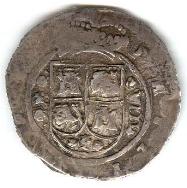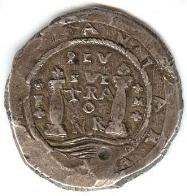
| Philip
V / Felipe V
8 Reales Assayer / Ensayador M 1742 Nuevo Reino 27.4 grams / gramos. |
|
Obverse: Quartered shield with arms of Castile and Leon in correct order, crown above. Pomegranate at bottom of shield, flanked each side by an ornament. Value VIII right of the shield reading downward. Left of the shield is the assayer mark "M" reading upward. The peripheral legend reads: PHILI (PVS V DG). Reverse: Pillars with waves design. The legend PLV / SVL / O / NR is above and between the columns. To the left of the columns is the letter "F" and to the right of the columns the letter "M". The final digit of the date 1742 is partially visible. The peripheral legend reads: (HISP)ANIARV(M REX 174)2. R/L M76-9, L/R M76S-9, C&T Type 143, Number 800. Anverso: Escudo cuarteado y coronado con las armas de Castilla y de León en orden correcto. Granada en la base del escudo, flanqueada a cada lado por un adorno. A la derecha del escudo el valor VIII, se lee hacia abajo. A la izquierda la marca de ensayador “M”, se lee hacia arriba. Alrededor la leyenda, PHILI(PVS V DG). Reverso: Pilares con olas. La leyenda PLV/SVL/O/NR, arriba y entre las columnas. A la izquierda de las columnas está la letra “F” y a la derecha una “M”. El dígito final de la fecha 1742 es parcialmente visible. La leyenda de la periferia ((HISP)ANIARV(M REX 174)2. R/L M76-9, L/R M76S-9, C&T Tipo 143, Número 800.
An extremely rare coin with only two pieces known. This coin came to market at the 2003 Chicago International Coin Fair, we were fortunate enough to be in attendance at Chicago and have the opportunity to touch and study this magnificent coin. The owner of the coin gave us permission to publish images of it, for which we are grateful and we hope the reader is too. This particular piece is not the plate coin in Restrepo, Lasser or Cálico, however the strike is better and it has very little wear from circulation. The coin has graffiti, the name "MARIA", written in script at 10 o'clock on the obverse, it is not visible in the image. It also has the beginnings of a hole on the reverse side in the waves. Even with these issues the coin is in extremely fine condition. It is also the plate coin in Herrera's 1914 classic work El Duro1. Herrera's catalog number is 794 and the coin is photographed on plate XVIII, coin number 6. Herrera listed the coins as Nicaragua and the mint as Nuevo Reino. Below is an excerpt from his description.
Solo se conocen dos ejemplares de esta extraordinaria pieza. Tuvimos la fortuna de estar presentes en la Feria Internacional de Chicago de 2003 donde pudimos ver y tocar y estudiar esta magnífica pieza. Su dueño nos autorizó publicar sus imágenes, lo cual agradecemos mucho y estoy seguro de que lo mismo sentirán los lectores. Esta moneda no es la misma que aparece en el libro de Restrepo en Lasser o en Calicó. La acuñación de esta moneda es superior y el desgaste es mínimo. Tiene un grafiti con el nombre “María” a las 10 del reloj en el anverso, no visible en la foto. Tiene también el intento de una perforación en el reverso a nivel de las olas. A pesar de esto la pieza es extrafina. También es la que aparece en la obra clásica de Herrera “El Duro”. Es el número 794 del catálogo del mismo autor y aparece reproducida en la tabla XVIII, moneda número 6. Herrera la clasificó como de Nicaragua y la ceca como Nuevo Reino. Al final se reproduce un resumen de su descripción.
"A pesar de no tener la fecha ni la numeral del Soberano parece indudable que esta moneda se fabricara en el reino de Felipe V, pues D. Antonio Vives tiene en su colección un real de a dos del miso tipo con fecha 1724 y hasta con la inicial F. del nombre del ensayador." In English, "In spite of the absence of a date and the king's ordinal, it seems that this coin must be Philip V since Mr. Antonio Vives has a one real in his collection of the same style with a date of 1724, and even the same assayer initial, F."
To our knowledge Herrera is the earliest published illustration of this coin.
Hasta donde sabemos Herrera fue el primero en publicar una ilustración de esta pieza.
Herrera's description is quite accurate and he brings up a point that is still unsettled almost a century later. What is the significance of the initials F and M on this coin? The M may likely be the assayer mark as the assayer of record at Santa Fé (Nuevo Reino) for the years 1732-1743 was Miguel Molano2.
La descripción de Herrera es bastante exacta y trae a colación un punto aún no resuelto: el significado de la letra “F” y “M”. La M probablemente corresponde al ensayador Miguel Molano2 de Santa Fé, Nuevo Reino, para los años 1732-43. |
(1)
Adolfo Herrera, El Duro (Madrid: J. Lacoste, 1914) Vol. I p. 237 and
plate XVIII.
(2) A.M. Barriga Villalba, Historia de la Casa de Moneda.
(Bogotá: Banco de la Republica (de Colombia) 3 tomos.1969.) Tomo I, p. 126
"En 18 de agosto de 1732 don Joseph Salvador
de Ricaurte, por providencia y autos de los señores de la Real Audencia,
nombró para reemplazar a Sánchez de la Torre imposibilitado por enfermedad
para desempeñar el cargo, a don Miguel Molano, quien era uno de los talladores
de la Casa de Moneda." p.132 "Fueron ensayadores de Don Tomás Prieto
de Salazar: Don Miguel Molano, en el año de 1743 y Don Sebastián de Rivera
desde el año 1743 hasta 1748". p 126 On August 18th, 1732 Mr. Joseph
Salvador de Ricaurte, through providence and resolutions of the Royal Audience
named Miguel Molano, who was one of the engravers at the mint, to replace
Sánchez de la Torre who could not carry out his duties due to
infirmities." p. 132 "The assayers under Tomás Prieto de Salazar,
Miguel Molano in the 1743 and Sebastián de Rivera from 1743 to 1748".
Spanish translation courtesy of Dr.
Jorge Emilio Restrepo. / La traducción en el español por la cortesía de Dr. Jorge Emilio Restrepo.
©Copyright Herman Blanton
2003, all
rights reserved.



